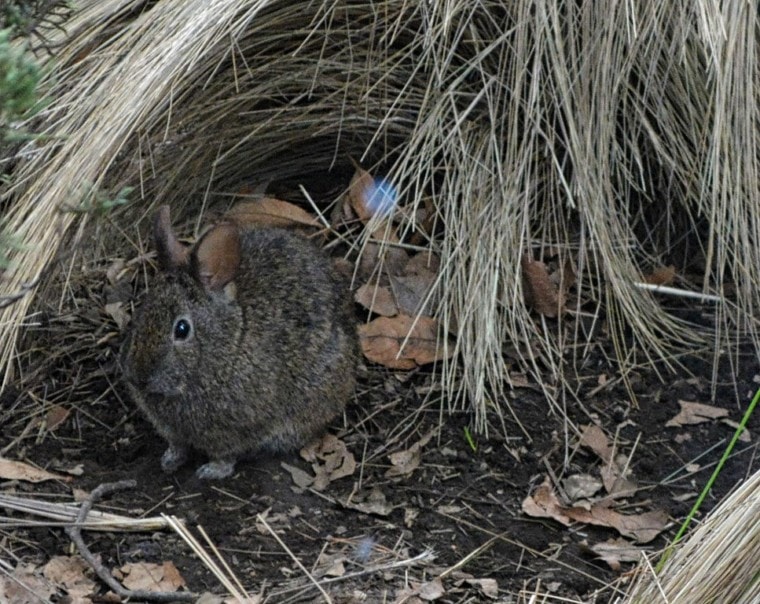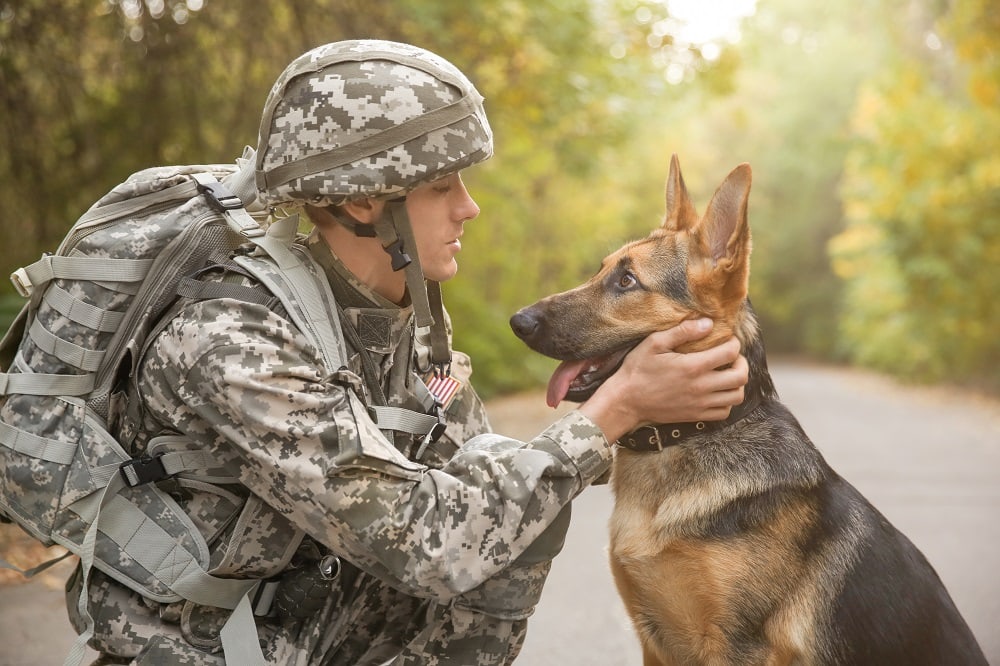
Click to Skip Ahead
As the name suggests, these tiny bunnies live on the slopes of volcanoes, less than an hour away from Mexico City. Volcano rabbits weigh about one pound and stick together to survive the wilderness. According to the IUCN, this is an endangered species, with around 7,000 on the planet. They hide in burrows and zacaton grass, but with the habitat changing for the worse, it’s becoming increasingly harder for Volcano rabbits to stay afloat.
Breed Overview
Size:
Miniature
Weight:
0.8–1.3 pounds
Lifespan:
7–9 years
Similar Breeds:
Riverine, Amami, Eastern Cottontail, and Pygmy rabbits
Suitable for:
Life in the wilderness (not built to be domestic pets)
Temperament:
Docile, alert, semi-social, aloof with strangers, crepuscular
The first thing to remember is that the Zacatuche rabbits (that’s what the locals call them) are wild animals—always have been. Outside of their own groups, they aren’t at all social and can’t adapt to the life of domestic pets. That means you should never try to adopt one, as that will only bring stress to the little guy, no matter how well you treat it.
So, how do these rabbits survive the wilderness? Why are they endangered? And what kind of food do they eat? Let’s find out!
Volcano Rabbit Characteristics
Temperament & Intelligence of the Volcano Rabbit
Volcano rabbits are intelligent, well-organized critters who follow strict rules when it comes to feeding, hiding from predators, and mating. They are vigilant and restless and rarely get separated from the rest of the group. They always watch each other’s back and work together to keep the “clique” alive. On its own, a single Volcano rabbit won’t be able to survive the harsh weather or the beasts of prey.
As for the temperament, the Zacatuche rabbits are alert, restless, and wary of strangers.
Do These Rabbits Make Good Pets? 👪
The short answer is no. The Volcano bunnies are NOT meant to be pets. They might look cute and fluffy, given their miniature size and pretty looks, but we strongly advise against adopting them. In contrast to domesticated species, these rabbits don’t like to be touched, cuddled, or held in captivity. They aren’t used to being separated from a group, either, and become extremely stressed and anxious when kept away from fellow bunnies and native lands.
Even if you bring the entire group home (2–5 members), that won’t make any difference, not to mention cost quite a lot. Like most wild animals, Volcano rabbits are impossible to domesticate—it’s just not in their DNA. Catching and keeping an animal that isn’t made to be captive is both dangerous and cruel. No hutch, no matter how big and fancy, will ever be able to make up for the lack of freedom. These rabbis are not “pet material”.
Does This Rabbit Get Along With Other Animals?
In the wilderness, Zacatuche rabbits are hunted by bigger, stronger predators and have to constantly be on high alert. We’re talking about hawks, bobcats, and weasels (the long-tailed ones). So, it’s understandable why these tiny buns don’t like to be around other creatures, be it cats, dogs, or even hamsters. Volcano rabbits are used to sticking together, and that’s pretty much the only company they’ll tolerate.
And one more thing: unlike most pups and kitties, Volcano rabbits don’t warm up or become more trusting with outsiders once they get to know each other. That’s another reason why these critters should never be adopted as pets. You won’t be able to make them a part of the family because they don’t take kindly to strangers (both herbivores and carnivores).
Things to Know About Volcano Rabbits
Food & Diet 🥕
Born on the rocky terrain atop Mexican volcanoes, Volcano rabbits feed on whatever they can find. Zacaton grass is their main source of food, but they also like to munch on local plants/herbs, foliage, shrubs, and tree bark. Now, they probably wouldn’t mind guzzling hay, pellets, and some tasty veggies and fruits. But, unfortunately, carrot tops, broccoli greens, or bananas aren’t available in their areas of habitat.
Zacaton grows on alpine slopes and easily handles the harsh climate (scorching sun, long periods without rain, and lack of nutrients), which makes it a reliable food source for Volcano rabbits.
Habitat 🏠
Volcano rabbits live in high altitudes atop four volcanoes in Mexico and stick to grasslands and pine woodland. They are rarely seen out in the open and instead stay in underground tunnels or use the tall zacaton grass as cover to move around when it’s dark outside. As crepuscular creatures, they like to take care of business at dusk or dawn: socialize, eat, and mate, among other things. If not for the grass and the burrows, this species wouldn’t have survived for this long.
Now, before the Mexican government started building roads, agricultural complexes, and entire settlements in the area, Volcano rabbits used to have one big, interconnected, and fertile habitat. Unfortunately, today, they are scattered all over the place, living in less than 20 detached chunks of land. More than that, due to human activity, it’s becoming harder for the zacaton seeds to take root. As a result, the bunnies have less food than before.
Population Threats
The local farmers often burn zacaton to make room for grass that cows and sheep can eat. Next, the climate in the area is changing rapidly, forcing the rabbits to find shelter higher up in the volcanoes/mountains. The temperatures are rising, making it impossible for them to satisfy their basic needs. Overall, Volcano rabbits are threatened by predators, unforgiving climatic conditions, livestock grazing, forest fires, and human expansion.
To them, we are an invasive species, one that’s constantly threatening their safety and standards of living, not to mention causing a huge food crisis. And, since the bunnies are spread all over the area in isolated patches of land (divided into up to 200 smaller groups), it’s becoming harder to communicate, send warnings, and create complex underground tunnels for quick navigation through the terrain.
Mating Habits
The scientific definition for Volcano rabbits is “semi-social”. They rely on each other to make it through the day and live in small groups (up to five members) with a clear chain of command. There’s only one dominant couple in each group, and those buns (a male and a female) are the only ones that mate. Also, it’s the female that leads the charge, not the male. The mating season starts when it gets hot and rainy, and it takes a female around 40 days to give birth to baby bunnies.
Male vs Female
You might think that Volcano males are larger than females, but it’s actually the other way around. The difference isn’t that big, but it’s still there. Most adult Volcano rabbits reach 8–9 inches in length (measure from the tip of the tail to the tip of the nose) and rarely go over 1.3 pounds in weight. Going back to gender roles, the ladies are the leaders both in the pack/group and in the breeding pair, and they’re often seen asserting dominance.
That’s right; in contrast to most dog and cat species, male Zacatuche rabbits are less aggressive than females. This somewhat unusual hierarchy has allowed Volcano rabbits to thrive in harsh environments for many centuries. Disturbing it will lead to catastrophic consequences for the entire group. Please keep that in mind when interacting with this breed.
3 Little-Known Facts About Volcano Rabbits
1. Volcano Is an Endangered Rabbit Species
Volcano rabbits are extremely rare: they’re officially categorized as an endangered breed. According to a recent report by the Red List of Threatened Species, currently, there are only 7,000 mature Volcano bunnies on the planet, and, sadly, the numbers are dropping.1 Due to the harsh environment and ongoing threats, it’s believed that the Zacatuche population might be significantly lower since the latest assessment (which took place back in 2018).
Most rabbits are found in Izta-Popo, with the rest scattered all over the neighboring territories. Local eco-activists and communities are doing their best to help boost the Volcano rabbit numbers, but they lack the necessary finances and expertise to turn the situation around. And no, bringing a Volcano rabbit home and trying to domesticate it won’t help the species; it will make matters much worse.
2. It’s the Second-Smallest Rabbit Breed
Did you know that most adult Volcano rabbits weigh less than one pound? That’s right! They’re incredibly tiny and officially recognized as the second-smallest bunnies after Pygmy rabbits. To put things into perspective, Volcano buns weigh 0.86–1.3 pounds, while Pygmy rabbits range from 0.827 to 1.102 pounds. These adorable creatures fit in one’s hand, don’t need much food to be happy, and live for up to nine years (the estimated lifespan is 7–9 years, which is the average for most rabbits).
This is important: Volcano rabbits are very slow. They can’t run away from predators and prefer to hide in underground tunnels or bunchgrass (zacaton grass) instead. Running for their lives is not an option! Next, in contrast to most rabbit species, they don’t thump their feet to alert fellow buns. Instead, the buns make high-pitched sounds (just like the tiny pikas) to reach each other over miles of dense forests. This allows groups and even colonies to stay one step ahead of potential threats.
3. Volcano Rabbits Live Near Volcanoes in Mexico
Native to the mountains in Mexico, Volcano rabbits do, indeed, live on the sides of four inactive volcanoes (and peripheral areas), approximately 10,000–12,000 feet above sea level. Volcano rabbits spend most of their time in burrows. Another interesting fact: to increase chances of survival, they create groups of 2–5 members and give birth to kitties (that’s what baby buns are called) in these burrows.
Life in the volcanic regions is rather tough, but since Zacatuche rabbits are endemic to this part of Mexico, they’ve learned to adapt despite the population decline. However, we (the humans) have played a major role in making life a lot harder for them. By building highways, farming the land, planting trees, mining, quarrying, hunting, and doing various recreational activities, we made the environment more challenging for Volcano rabbits.
Final Thoughts
Volcano rabbits are tiny yet incredibly resourceful, intelligent, and hardened buds. More importantly, they’re not meant to be domesticated: the wilderness is their home. So, if you’re planning to bring home a bunny, pick a domestic breed. As we stressed multiple times throughout this guide, Volcano rabbits are creatures of the wild. They have a hard time adjusting to new environments and get anxious or even die when held against their will.
This is an endangered species, and the last thing that will help them survive is life in captivity, removed from their native lands and way of life. Therefore, if you want to help these precious critters make it through the tough times, consider donating to local communities. They are doing their best to keep Volcano rabbits alive!
Featured Image Credit: Romerolagus diazi – ProtoplasmaKid, Wikimedia Commons CC BY-SA 4.0)









